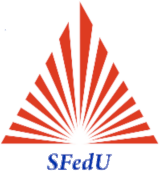Abstract of the educational program for the training of scientific and scientific-pedagogical personnel in Postgraduate studies of the scientific specialty
2.2.13 Radio engineering, including television systems and devices. Radio engineering, including television systems and devices
1. Languages of education: Russian, English (optional)
2. Campus: Taganrog, Institute of Radio Engineering Systems and Control
Program Overview:
The field of science and technology includes the use of electromagnetic waves to transmit and receive information in television and radio communications, in metrology, biology, medicine, and industrial technology. The specialty includes research, development, design and operation of television and radio communication devices for various purposes.
The fields of professional activity in this specialty are scientific and research activities in the field of:
- study of processes and phenomena in radio engineering, allowing to increase the efficiency of radio engineering devices and systems;
- research of methods and algorithms for processing radio signals that take into account the effects of their scattering and reflection when passing through various propagation media;
- development and research of radio engineering devices and systems that improve the characteristics of accuracy, performance and noise immunity;
- development and research of devices for generating, amplifying, converting and synthesizing radio signals, image and sound signals in radio engineering systems for various purposes, including television systems;
- development and research of algorithms, including digital ones, for processing signals and information in radio engineering devices and systems for various purposes, including synthesis and optimization of processing algorithms;
- development and research of methods to ensure electromagnetic compatibility of radio engineering systems and devices, including communication and television systems, methods to ensure their resistance to electromagnetic and ionizing radiation, methods of destruction and protection of information in these systems.
Research directions:
1. Research of processes and phenomena in radio engineering, allowing to increase the efficiency of radio engineering devices and systems.
2. Research of methods and algorithms for processing radio signals that take into account the effects of their scattering and reflection when passing through various propagation media.
3. Development and research of radio engineering devices and systems that improve the characteristics of accuracy, speed and noise immunity.
4. Development and research of devices for generating, amplifying, converting and synthesizing radio, image and sound signals in radio engineering systems for various purposes, including television systems. Creation of effective methods of their calculation and the basics of design.
5. Development and research of algorithms, including digital ones, for processing signals and information in radio engineering devices and systems for various purposes, including synthesis and optimization of processing algorithms.
6. Development and research of methods and algorithms for signal and information processing in radio engineering devices and systems for various purposes, including television and information transmission systems, when the presence of interference in order to increase noise immunity.
7. Development and research of methods to ensure electromagnetic compatibility of radio engineering systems and devices, including communication and television systems, methods to ensure their resistance to electromagnetic and ionizing radiation, methods of destruction and protection of information in these systems.
8. Development and research of radio engineering devices and information transmission systems, including terrestrial, radio relay and space, in order to increase their bandwidth, noise immunity and noise immunity.
9. Research and development of television systems and devices, including matrix photodetectors, television cameras, including with IP interfaces, digital codecs, modems, and devices for transmitting and reproducing images and sound, as well as methods and algorithms for modulation, demodulation, information compression, and noise-resistant encoding and decoding of signals.
10. Development and research of methods and devices for transmitting, receiving, processing, displaying, registering, storing and distributing information, including wireless, space, terrestrial, cable and mobile information transmission systems.
11. Development of information technologies, including digital ones, as well as using neural networks for recognition of signals, images and speech in intelligent radio engineering and robotic vision systems.
12. Development of methods to improve the clarity, color rendering quality, absolute and contrast sensitivity of images generated and used in broadcast and applied television systems.
13. Creation of a theory of synthesis, analysis and adaptation of radio engineering devices and systems, algorithms for processing signals and information in these systems.
14. Development and research of modeling methods for radio engineering devices and systems, including digital television systems of high, ultra-high, ultra-high definition and other formats, for television broadcasting and special applications.
15. Development and research of physical, mathematical and hybrid simulation models of radio engineering devices and systems, including analog and digital television systems and optoelectronic devices.
16. Development of scientific and technical foundations for the design, construction, production technology, testing and certification of radio and television devices and systems, including black-and-white, color, spectral, infrared, terahertz and multi-angle television systems, passive and active surround television systems.
17. Development of methods and devices for television measurements, including colorimetry, quantitative assessment of the quality of generated, transmitted and reproduced video information.
18. Development of radio and television equipment and systems for their use in industry, robotics, aviation, astronautics, astronomy, metrology, information and measurement technology, as well as for underground, underwater and other applications.

